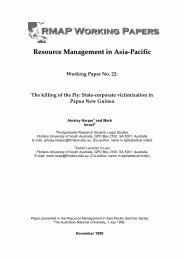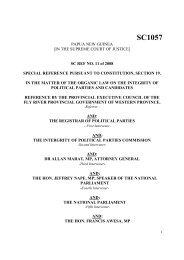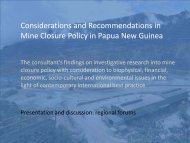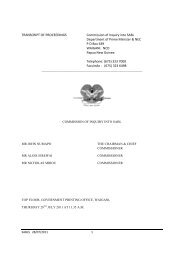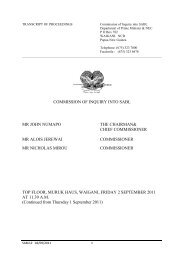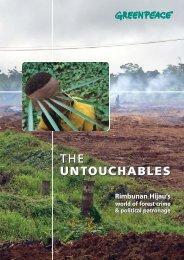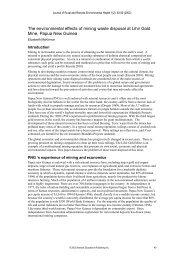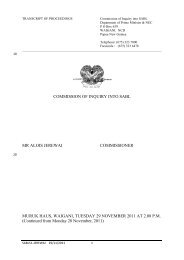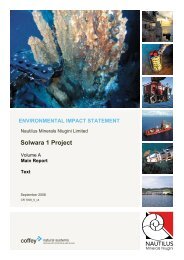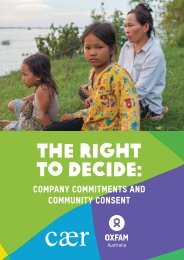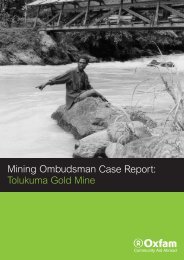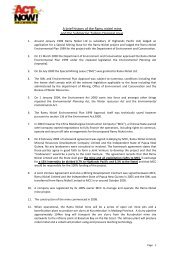Fishy business. The Social Impact of SST.pdf - Act Now!
Fishy business. The Social Impact of SST.pdf - Act Now!
Fishy business. The Social Impact of SST.pdf - Act Now!
Create successful ePaper yourself
Turn your PDF publications into a flip-book with our unique Google optimized e-Paper software.
pool <strong>of</strong> low-cost labour. This is in turn because Wewak and the Sepik are relativelyundeveloped in a modern economy sense; it provides the company with a good investmentopportunity. As part <strong>of</strong> the quid pro quo for this, the <strong>SST</strong>C should undertake to take an activepart in sustainable development <strong>of</strong> not just Wewak but the province. <strong>The</strong> company has said itwill do this in its Environmental Plan. What is needed now is the detail <strong>of</strong> how this will happen.As noted above, WWF is working with Provincial and Local Level Government on this issuealready; as a major developer, <strong>SST</strong>C should be prepared to invest both time and money into thisprocess. On the assumption the tuna factory is given approval to go ahead, discussions on theextent to which the company should do this should be part <strong>of</strong> the next phase <strong>of</strong> the development.n. Factory site visitsVisit <strong>of</strong> 8/7/05. A group <strong>of</strong> St. Benedict’s College lecturers and associates visited the factory at9 am, and were warmly welcomes by the Community Relations Officer, Frances Sumanup. Hewas happy to have representatives from educational institutions come see and appreciate whatwill be generating income for the Sepik people. South Seas Tuna Corporation’s first year <strong>of</strong>operation was 2004. It was opened Feb 14, 2004. <strong>The</strong> company is in partnership, Sumanupsaid, with:! FCF <strong>of</strong> Taiwan! Jacksons <strong>of</strong> the Neatherlands! BSP! <strong>The</strong> East Sepik Provincial GovernmentInterestingly, this information does not conform to what we were told on a second visit, whenIan Boatwood himself said FCF and the ESPG were the sole owners.Visitors took notes on the processes that were explained by company representatives as theymoved through the factory. For examples:<strong>The</strong> company aims to produce 200 tonnes <strong>of</strong> tuna per day, but cannot at present because there isno direct shipment <strong>of</strong> the loins to Western Samoa for canning. <strong>The</strong> product has to pass throughLae and then to Western Samoa at present. <strong>SST</strong> exports 12 containers <strong>of</strong> fish a week.<strong>The</strong> receiving section measures the fish and weighs it, then sends it to the freezer section. <strong>The</strong>freezer section stores the fish and removes it to the butchery section. As much as 750 fish arestored and removed at a time. <strong>The</strong>y cut and supply it to the steaming section where they steamthe fish and send it to the cooler section, where they store the fish and send it to the loiningsection, where they skin and then remove the red meat from the fish with the bones and produceand pack the white meat.Landowners<strong>The</strong> State has agreed to provide the land for 10 years. <strong>The</strong>re are no spin <strong>of</strong>fs <strong>of</strong>fered by thecompany. <strong>The</strong> company would point to the Provincial Government to assist landowners toorganize and so provide bus and canteen services.<strong>The</strong> impression given was that there hasn’t been good liaison between <strong>SST</strong> and the ProvincialGovernment. <strong>The</strong>n-Governor Authur Somare brought in the project but did not have any ideawhatsoever <strong>of</strong> how to help the people.84



